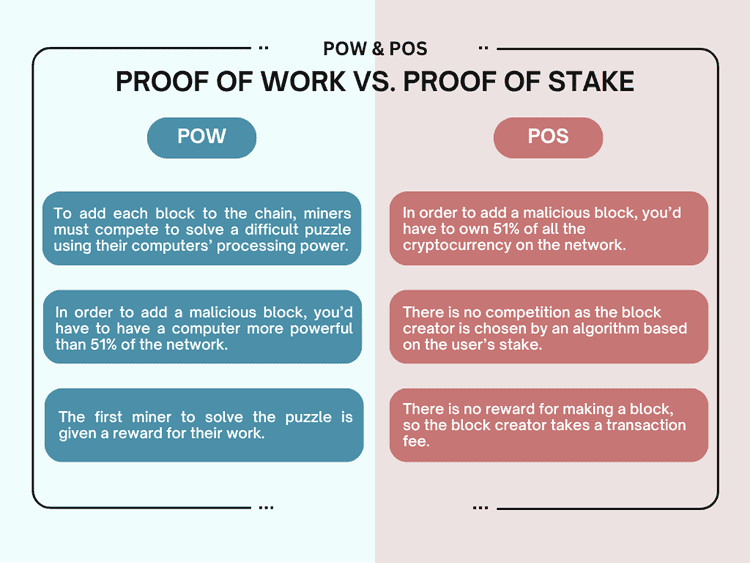Proof of Work vs. Proof of Stake: Key Differences


In the high-stakes world of blockchain, consensus mechanisms are the invisible engines powering decentralization, and the battle between Proof of Work (PoW) and Proof of Stake (PoS) is rewriting the rules of trust, security, and scalability. Two primary mechanisms, Proof of Work and Proof of Stake, have emerged as foundational pillars in this domain. Understanding their differences is crucial for anyone interested in the future of cryptocurrencies and blockchain applications.
What is Proof of Work?
Proof of Work is the original consensus algorithm introduced by Bitcoin. It requires network participants, known as miners, to solve complex mathematical puzzles to validate transactions and add new blocks to the blockchain. This process is computationally intensive and ensures that altering any part of the blockchain would require immense computational power, thereby securing the network.
How PoW Secures Blockchain Networks?
The security of PoW-based networks hinges on the computational effort required to solve cryptographic puzzles. This mechanism makes it economically unfeasible for malicious actors to alter transaction history, as they would need to control over 50% of the network's total computational power, a scenario known as a 51% attack. The decentralized nature of mining, where numerous miners compete to validate transactions, further enhances the network's resilience against attacks.
What is Proof of Stake?
Proof of Stake emerged as an alternative to PoW, aiming to address its energy inefficiencies. In PoS, validators are chosen to create new blocks based on the amount of cryptocurrency they hold and are willing to "stake" as collateral. This method reduces the need for energy-intensive computations, as validators are selected in a pseudo-random manner, often influenced by the size of their stake and the duration it has been held.
Differences in Validation Approach
Unlike PoW, where miners expend energy to solve puzzles, PoS selects validators based on their economic stake in the network. This shift not only reduces energy consumption but also aligns the interests of validators with the health of the network, as malicious behaviour could result in the loss of their staked assets. Additionally, PoS can offer faster transaction times and lower fees, enhancing the overall efficiency of the blockchain.
Understanding the Trade-offs: PoW vs. PoS Across Critical Dimensions
As blockchain technology continues to evolve, choosing the right consensus mechanism is essential for balancing performance, sustainability, and security. This section compares Proof of Work (PoW) and Proof of Stake (PoS) across three critical dimensions: energy consumption and environmental impact, security and decentralization, and scalability and future adoption. By examining these areas, we can better understand the strengths and trade-offs of each approach and their implications for the future of decentralized networks.
Energy Consumption and Environmental Impact
The environmental footprint of blockchain networks has become a significant concern, particularly with PoW mechanisms.
Criticism of PoW's High Energy Usage
PoW networks, especially Bitcoin, have been criticized for their substantial energy consumption. Estimates suggest that Bitcoin mining consumes approximately 112 terawatt-hours of electricity annually, comparable to the energy usage of some small countries. This high energy demand contributes to increased carbon emissions and electronic waste, raising sustainability concerns.
PoS's Environmental Advantages
In contrast, PoS mechanisms significantly reduce energy consumption. For instance, Ethereum's transition from PoW to PoS, known as "The Merge," resulted in a 99.95% reduction in energy usage. This dramatic decrease underscores PoS's potential as a more environmentally friendly alternative, aligning blockchain technology with global sustainability goals.
Security and Decentralization
Security and decentralization are core tenets of blockchain technology, and both PoW and PoS offer unique approaches to uphold these principles.
PoW's Computational Security
PoW's security model relies on the computational difficulty of solving cryptographic puzzles. The immense energy and resources required to alter the blockchain deter malicious activities. Moreover, the decentralized nature of mining, with numerous participants worldwide, ensures that no single entity can easily control the network.
PoS's Staking-Based Security
PoS enhances security by requiring validators to stake their assets, creating a financial incentive to act honestly. If a validator attempts to compromise the network, they risk losing their staked assets. This economic deterrent, combined with the random selection of validators, maintains network integrity. However, concerns about centralization arise if a small number of validators hold significant stakes, potentially influencing the network's governance.
In Ethereum's May 2025 Pectra Upgrade, validator staking limit has increased to 2,048 ETH (EIP-7251) which is a major step to enhance decentralization.
Scalability and Future Adoption
Scalability is a critical factor for the widespread adoption of blockchain technology.
PoW's Scalability Challenges
PoW networks often face scalability issues due to the time and energy required for mining. The limited transaction throughput can lead to network congestion and higher fees during peak usage. These limitations hinder the ability of PoW-based blockchains to support large-scale applications and user bases.
PoS's Scalability Potential
PoS offers improved scalability by enabling faster block creation and transaction validation without the need for energy-intensive computations. This efficiency allows PoS networks to handle higher transaction volumes, making them more suitable for applications requiring rapid processing and low fees. The enhanced scalability positions PoS as a favourable option for future blockchain developments.

Conclusion
Both Proof of Work and Proof of Stake serve as foundational consensus mechanisms in the blockchain ecosystem, each with distinct advantages and challenges. PoW offers robust security through computational effort, but at the cost of high energy consumption and scalability limitations. PoS addresses these concerns by providing energy efficiency and improved scalability, though it introduces considerations regarding stake centralization. As blockchain technology continues to evolve, the choice between PoW and PoS will significantly influence the sustainability, security, and scalability of decentralized networks.
Resources
Frequently asked questions
Check out most commonly asked questions, addressed based on community needs. Can't find what you are looking for?
Contact us, our friendly support helps!
What are the main differences between Proof of Work and Proof of Stake?
Proof of Work relies on computational power to validate transactions, leading to high energy consumption. In contrast, Proof of Stake selects validators based on their staked assets, offering a more energy-efficient approach.
Why is Proof of Stake considered more environmentally friendly?
Proof of Stake eliminates the need for energy-intensive mining processes, significantly reducing electricity usage and carbon emissions compared to Proof of Work systems.
Can Proof of Stake provide the same level of security as Proof of Work?
While both mechanisms aim to secure the network, Proof of Stake uses economic incentives and penalties to maintain integrity, which can offer comparable security to the computational challenges employed in Proof of Work.




